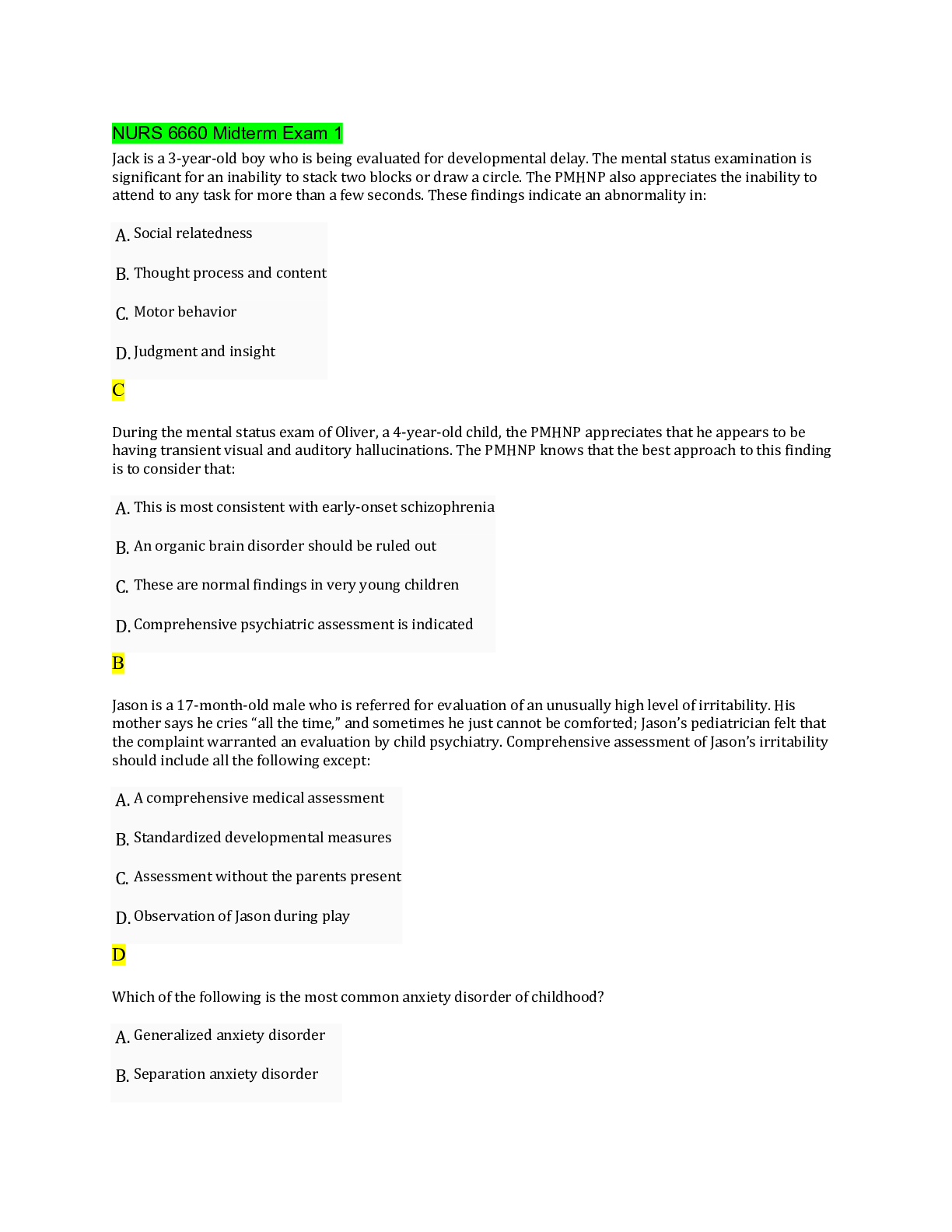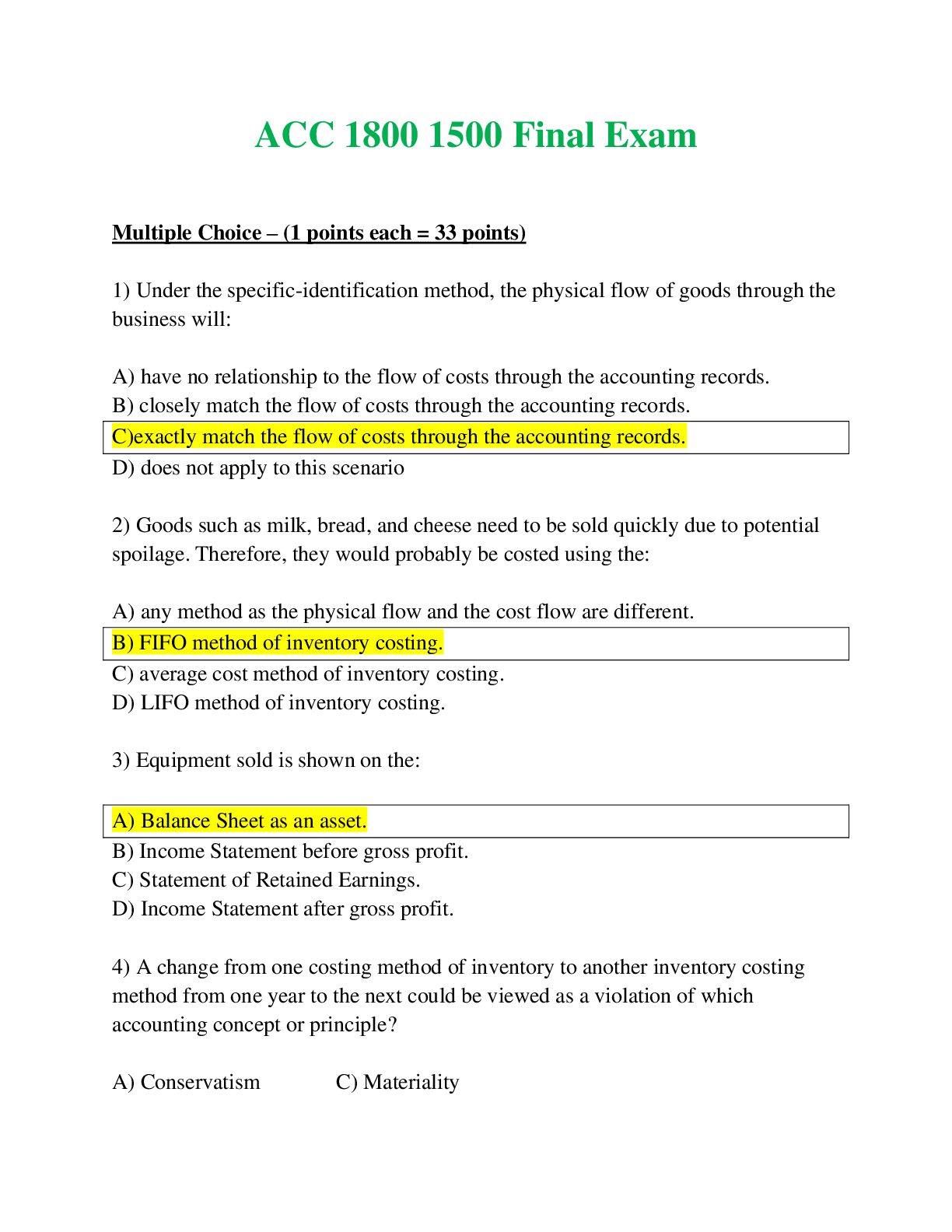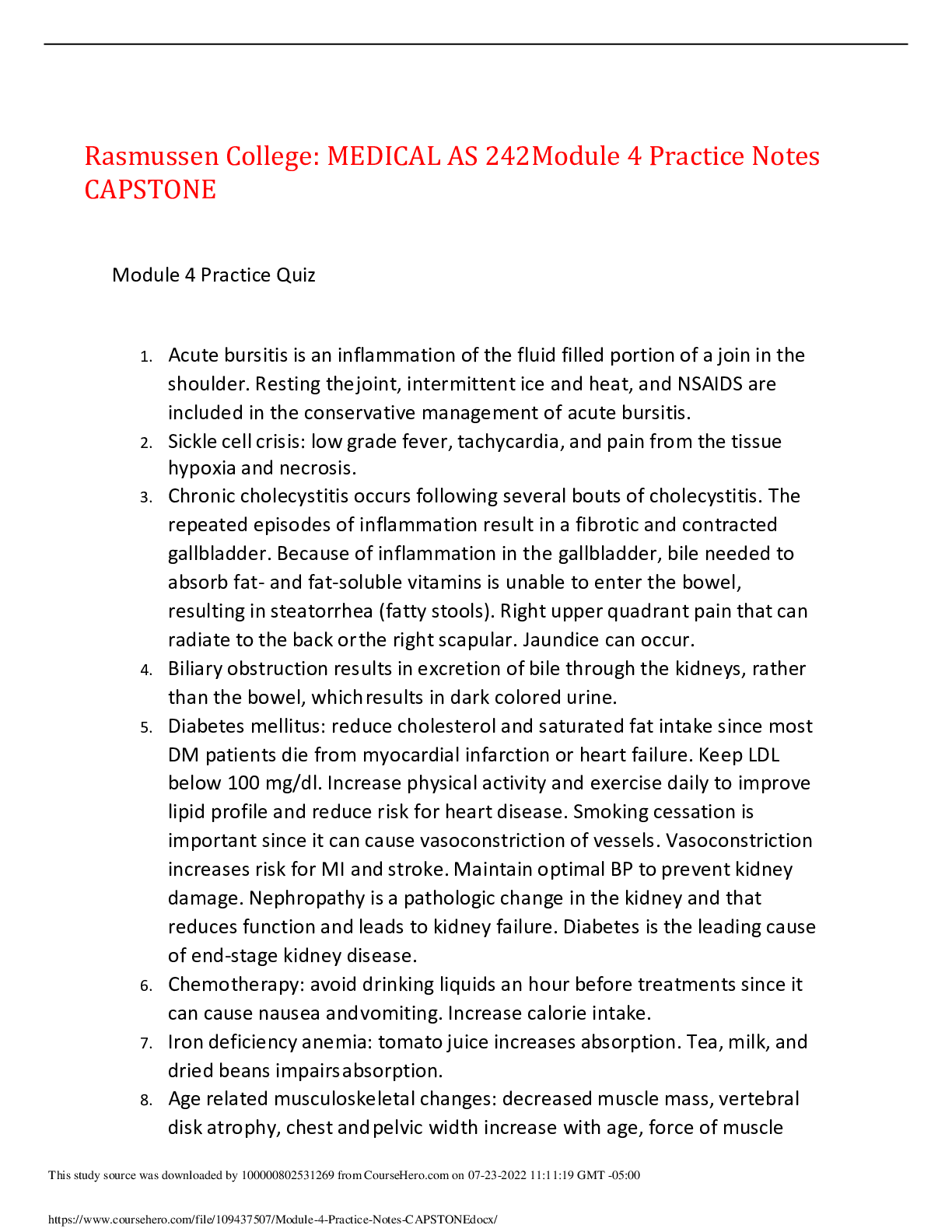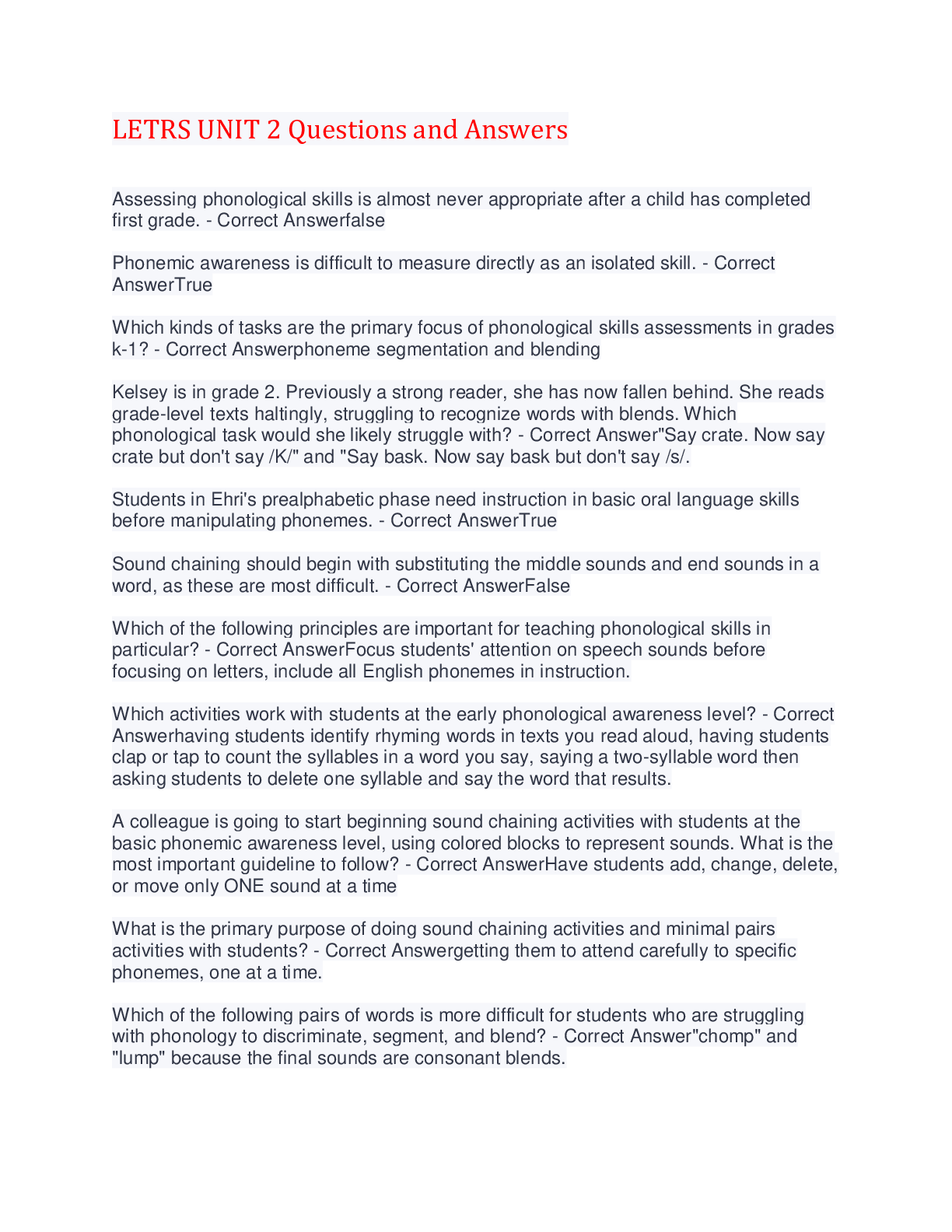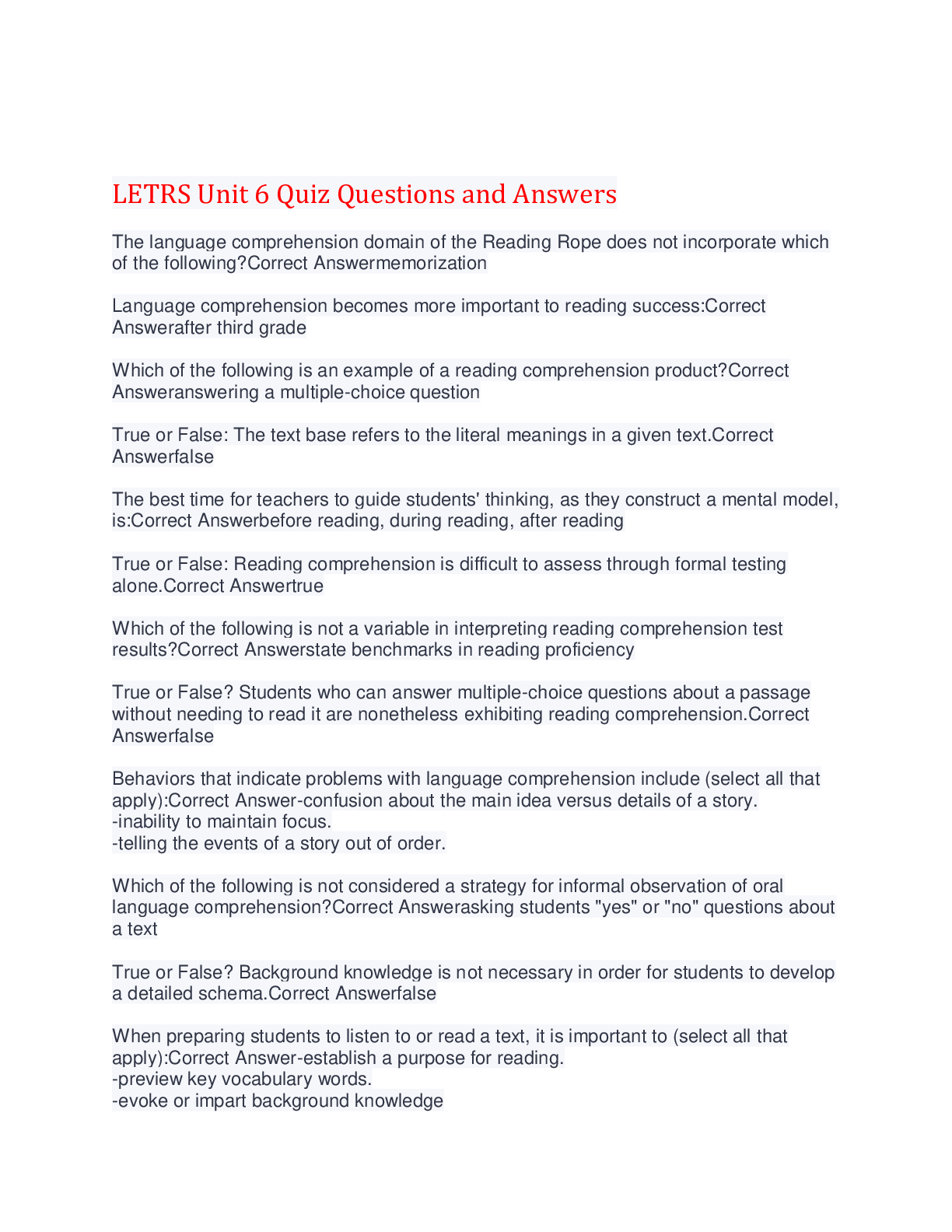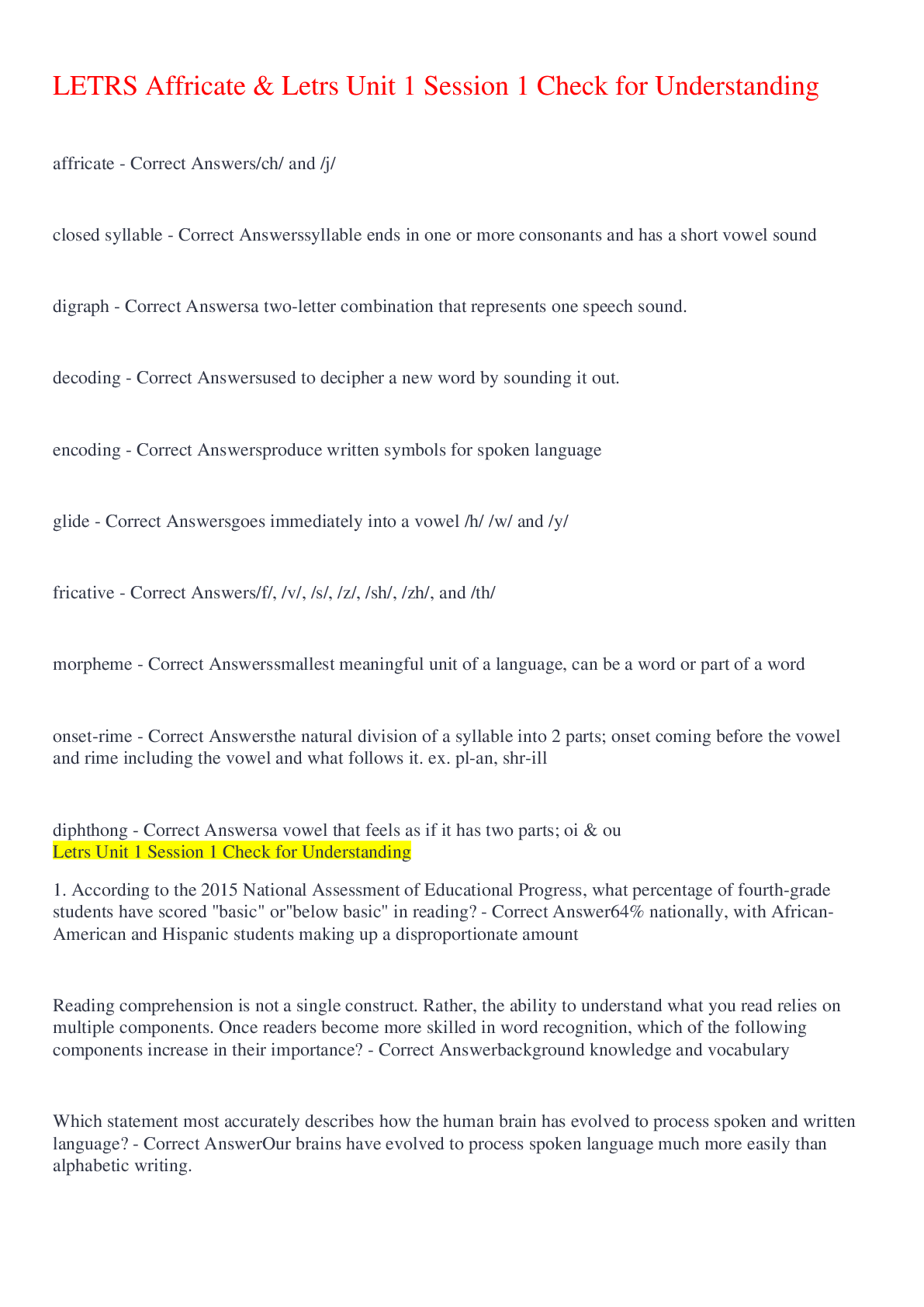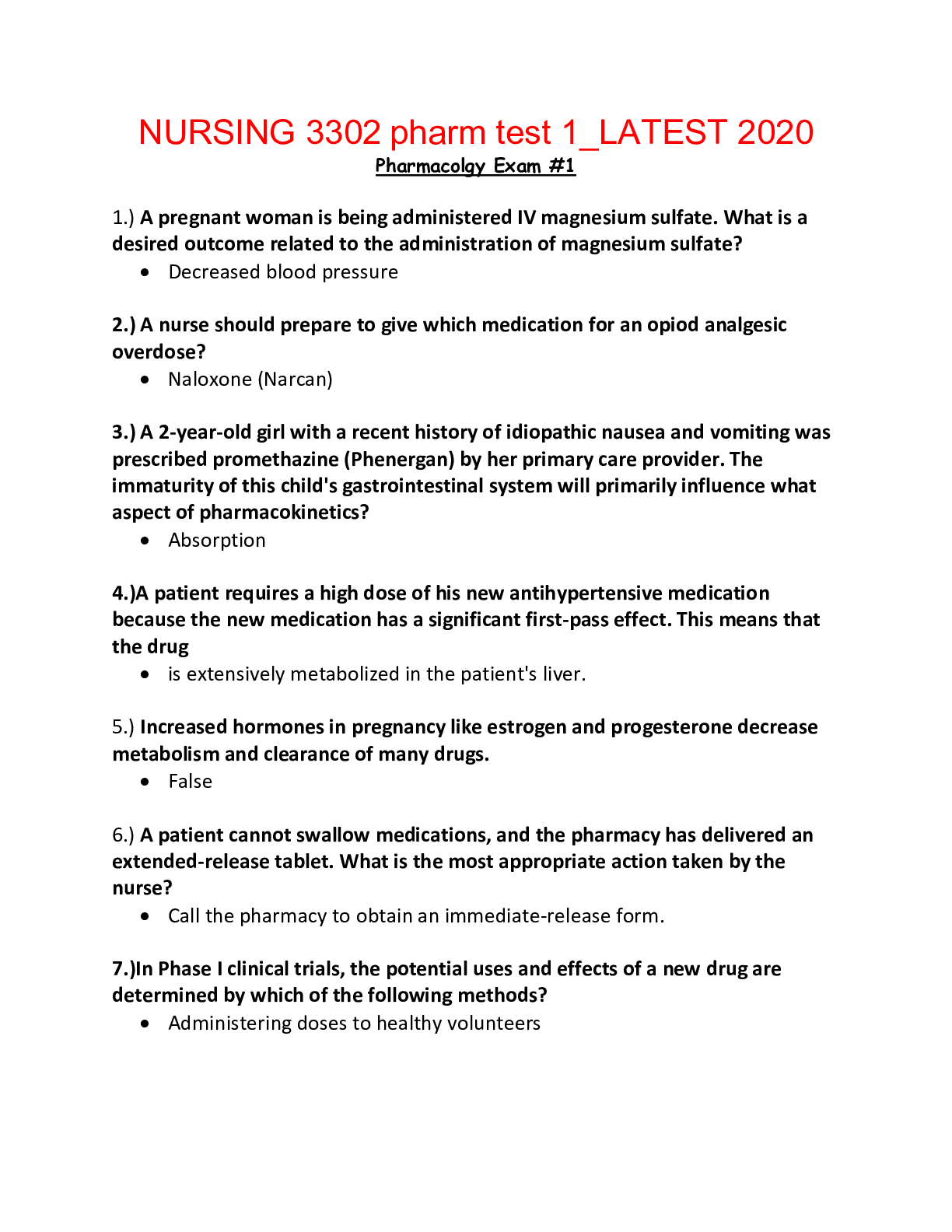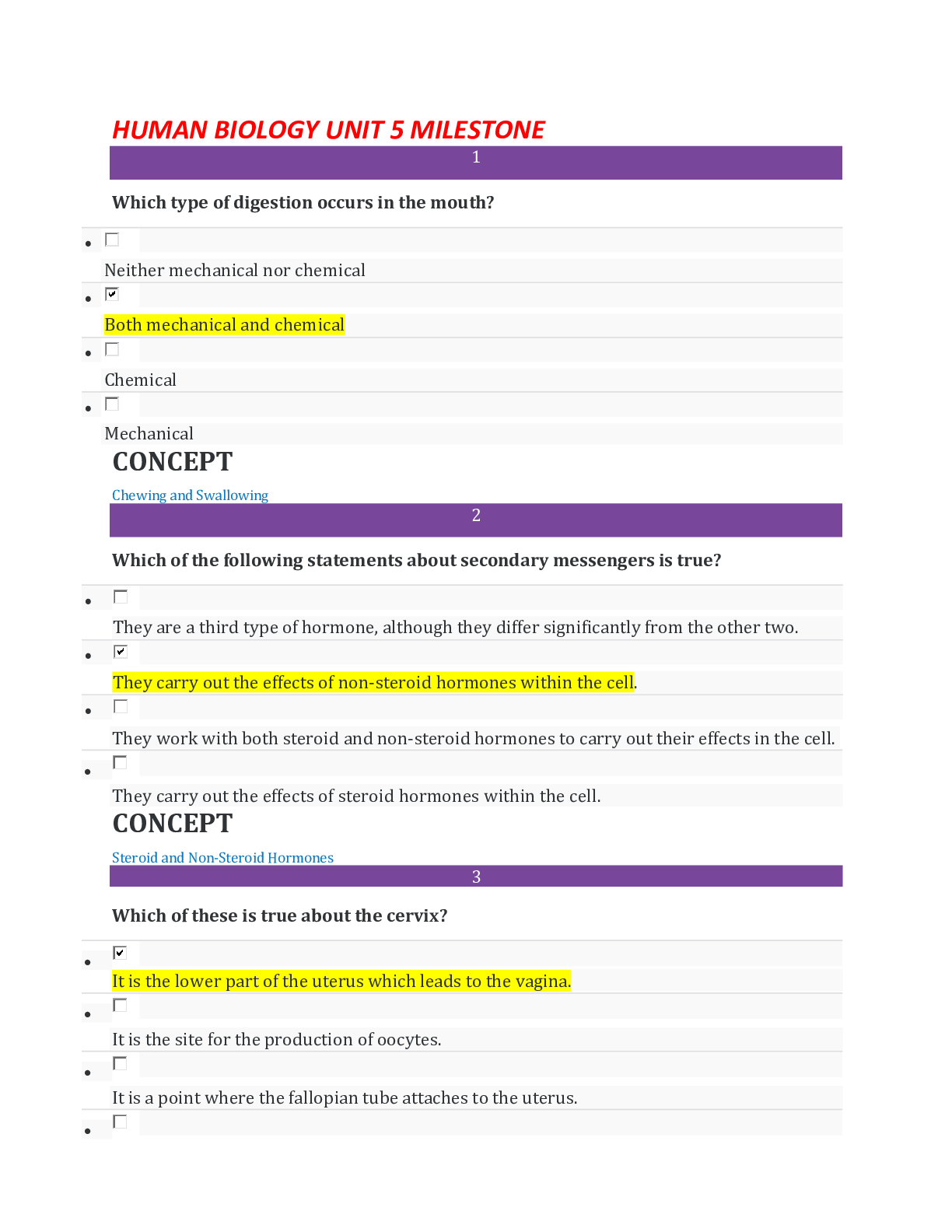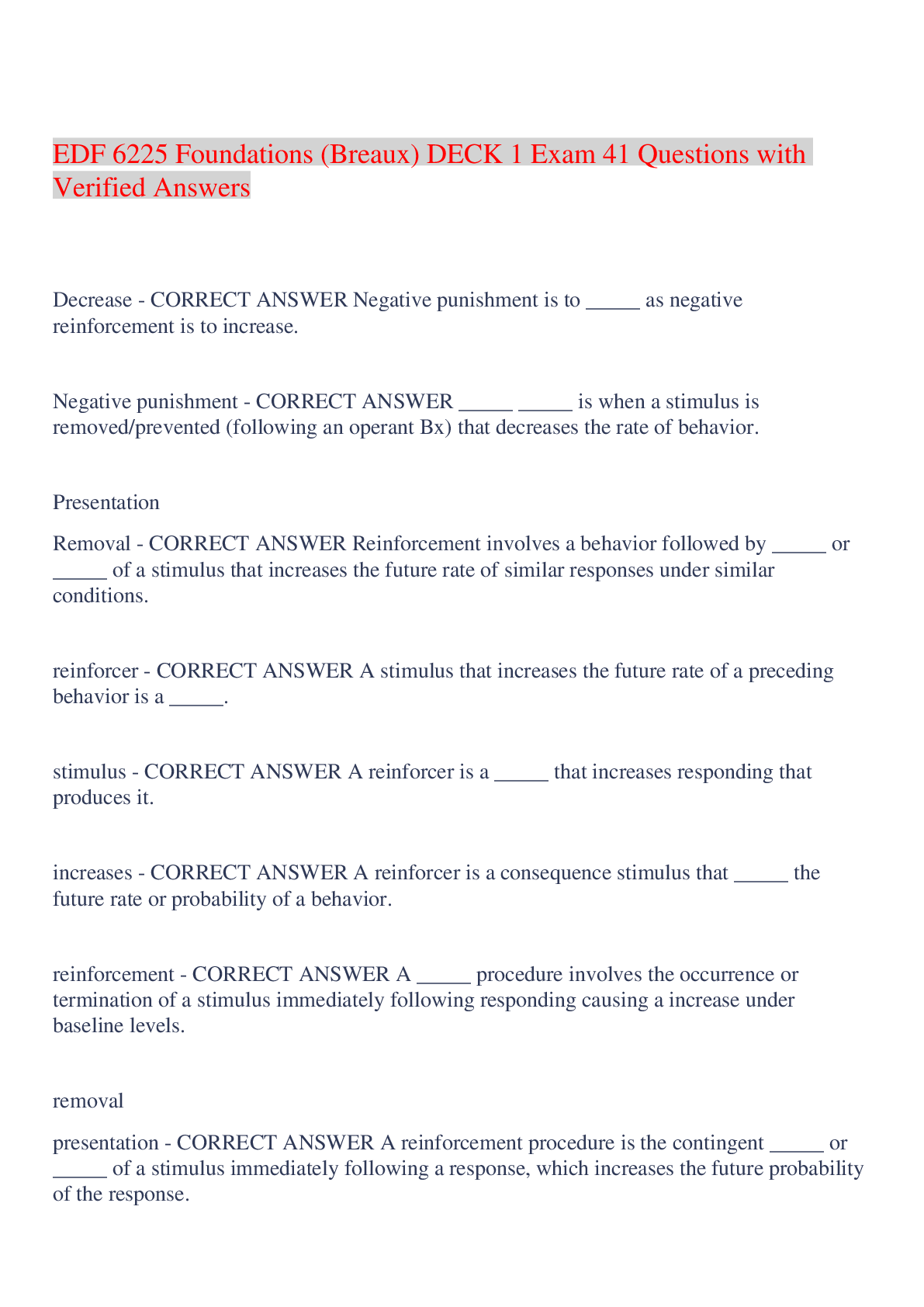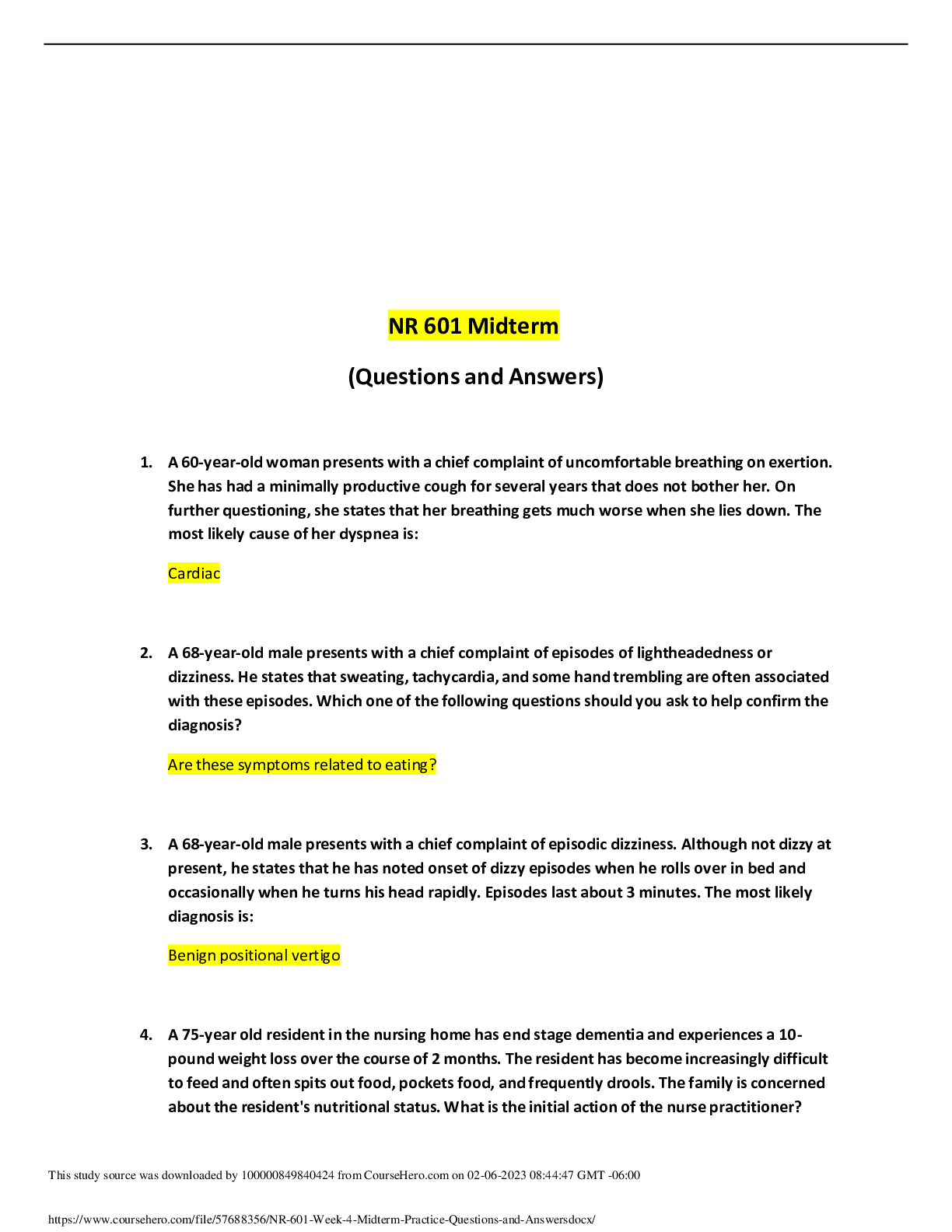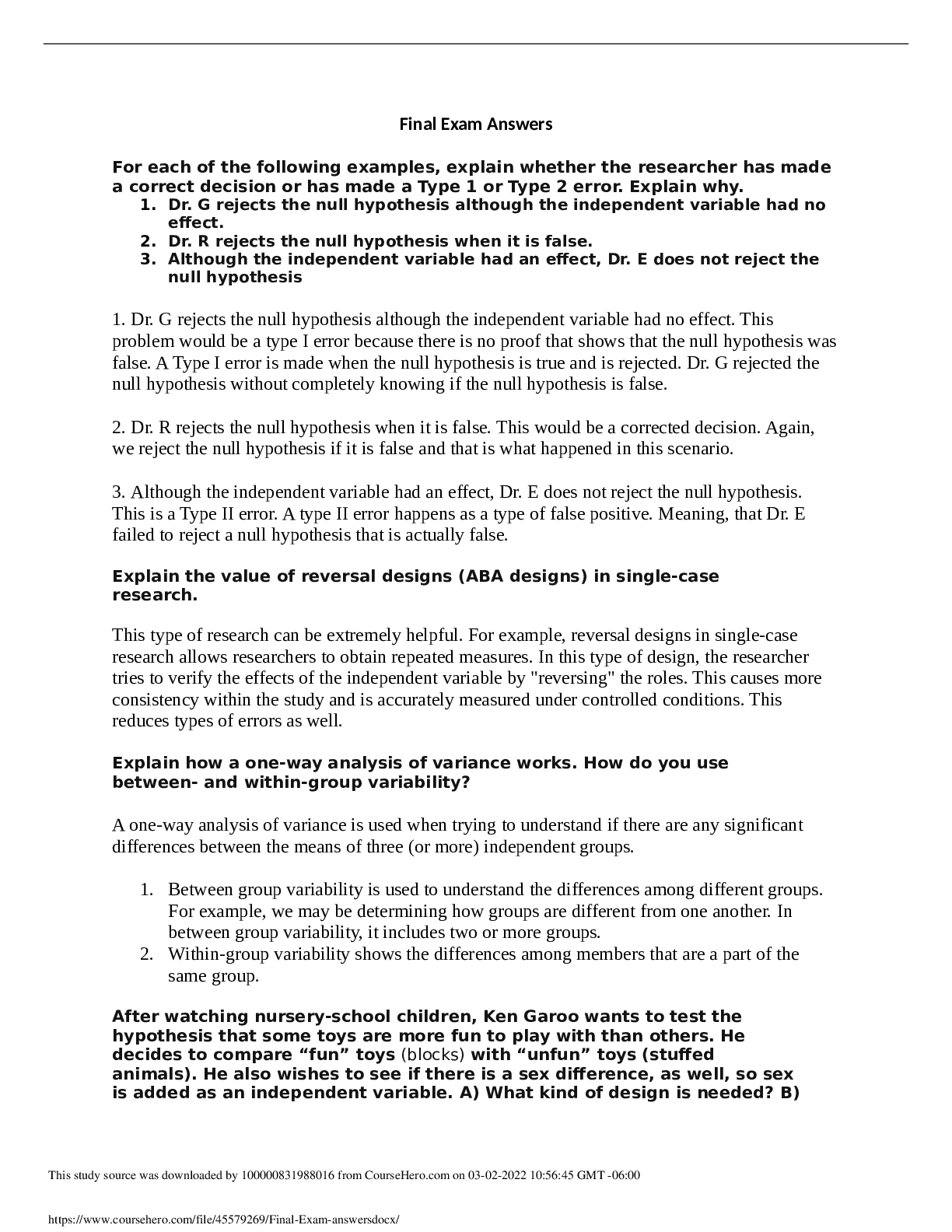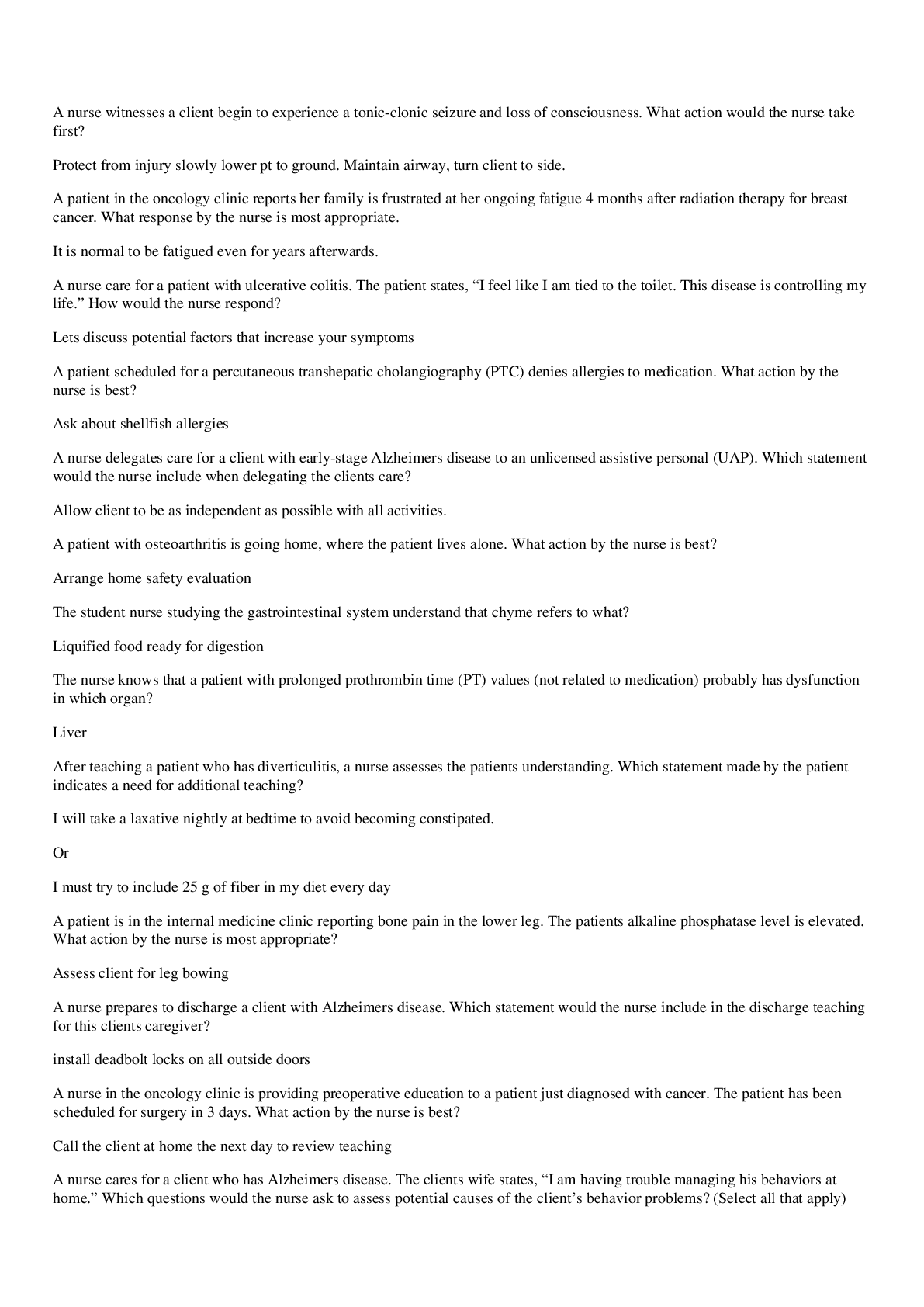*NURSING > EXAM > Florida University: NUR 3125 Week 6 Chapter 44 Questions and Answers,100% CORRECT (All)
Florida University: NUR 3125 Week 6 Chapter 44 Questions and Answers,100% CORRECT
Document Content and Description Below
Florida University: NUR 3125 Week 6 Chapter 44 Questions and Answers A client has been diagnosed with cholecystitis (gallbladder inflammation) that has impaired the normal release of bile. Which of t... he following gastrointestinal consequences is this client likely to experience? You selected: Impaired digestion of fats Correct Explanation: Bile performs a central role in fat metabolism. Gallbladder disease and the accompanying disruption of normal bile release do not result in impaired digestion of carbohydrates, imp ... (more) Reference: Grossman S, Porth CM (2014). Porth’s Pathophysiology: Concepts of Altered Health States. 9th ed. Philadelphia: Lippincott Williams & Wilkins, Chapter 44, Structure and Function of the Gastrointestinal System, p. 1167. Chapter 44: Structure and Function of the Gastrointestinal System - Page 1167 Question 2: (see full question) A student is comparing the different parts of the gastrointestinal (GI) tract. Which of the following statements demonstrates understanding? You selected: "The mouth is the receptacle where initial digestive processes take place." Correct Explanation: The GI tract can be divided into three parts: upper, middle, and lower segments. The upper part contains the mouth and esophagus and acts as a receptacle through which food passes ... (more) Reference: Grossman S, Porth CM (2014). Porth’s Pathophysiology: Concepts of Altered Health States. 9th ed. Philadelphia: Lippincott Williams & Wilkins, Chapter 44, Structure and Function of the Gastrointestinal System, p. 1151. Chapter 44: Structure and Function of the Gastrointestinal System - Page 1151 Question 3: (see full question) Colonic microorganisms play a role in the synthesis of which of the following vitamins? You selected: K Correct Explanation: Colonic microorganisms play a role in vitamin synthesis and in absorption of calcium, magnesium, and iron. Colonic flora synthesize vitamin K. Reference: Grossman S, Porth CM (2014). Porth’s Pathophysiology: Concepts of Altered Health States. 9th ed. Philadelphia: Lippincott Williams & Wilkins, Chapter 44, Structure and Function of the Gastrointestinal System, p. 1165. Chapter 44: Structure and Function of the Gastrointestinal System - Page 1165 Question 4: (see full question) Which functions apply to gastrointestinal secretions? Select all that apply. You selected: • Reabsorption of fluid in the small and large intestines • Secretion of enzymes and fluids • Protection of the mucosal layer Correct Explanation: Throughout the GI tract, secretory glands serve two basic functions: production of mucus to lubricate and protect the mucosal layer of the GI tract wall and secretion of fluids and ... (more) Reference: Grossman, S. & Porth, C.M. Porth's Pathophysiology: Concepts of Altered Health States, 9th ed., Philadelphia: Lippincott Williams & Wilkins, 2014, Chapter 44, Structure and Function of the Gastrointestinal System, p. 1162. Chapter 44: Structure and Function of the Gastrointestinal System - Page 1162 Question 5: (see full question) Fat that is not absorbed in the intestine is excreted in the stool. Which of the following terms is used to describe fatty stools? You selected: Steatorrhea Correct Explanation: Fat that is not absorbed in the intestine is excreted in the stool. Steatorrhea is the term used to describe fatty stools. Chyme is produced in the stomach as proteins are broken d ... (more) Reference: Grossman S, Porth CM (2014). Porth’s Pathophysiology: Concepts of Altered Health States. 9th ed. Philadelphia: Lippincott Williams & Wilkins, Chapter 44, Structure and Function of the Gastrointestinal System, p. 1167. Chapter 44: Structure and Function of the Gastrointestinal System - Page 1167 Question 6: (see full question) The physiological rationale for hanging normal saline (0.9% NS) or 5% dextrose in water (D5W) to a client who has been experiencing diarrhea includes: You selected: Activation of the ATP channels Incorrect Correct response: Facilitating the absorption of osmotically active particles Explanation: Water absorption from the intestine is linked to absorption of osmotically active particles, such as glucose and sodium. It follows that an important consideration in facilitating ... (more) Reference: Grossman, S. & Porth, C.M. Porth's Pathophysiology: Concepts of Altered Health States, 9th ed., Philadelphia: Lippincott Williams & Wilkins, 2014, Chapter 44, Structure and Function of the Gastrointestinal System, p. 1167. Chapter 44: Structure and Function of the Gastrointestinal System - Page 1167 Question 7: (see full question) Which of the following statements most accurately describes the function of the secretory glands in the gastrointestinal (GI) tract? You selected: Each day approximately 2000 mL of fluid is secreted into the GI tract. Incorrect Correct response: The secretory glands produce mucus to lubricate and protect the mucosal layer of the GI tract wall. Explanation: Secretory glands in the GI tract serve two basic functions: production of mucus to lubricate and protect the GI tract wall and secretion of fluids and enzymes to aid in digestion a ... (more) Reference: Grossman S, Porth CM (2014). Porth’s Pathophysiology: Concepts of Altered Health States. 9th ed. Philadelphia: Lippincott Williams & Wilkins, Chapter 44, Structure and Function of the Gastrointestinal System, p. 1162. Chapter 44: Structure and Function of the Gastrointestinal System - Page 1162 Question 8: (see full question) Which of the following statements is true concerning gastric enterocytes? You selected: They secrete enzymes that aid in digestion of proteins. Correct Explanation: Gastric enterocytes secrete enzymes that aid in the digestion of carbohydrates and proteins. Reference: Grossman S, Porth CM (2014). Porth’s Pathophysiology: Concepts of Altered Health States. 9th ed. Philadelphia: Lippincott Williams & Wilkins, Chapter 43, Disorders of Gastrointestinal Function, p. 1166. Chapter 44: Structure and Function of the Gastrointestinal System - Page 1166 Question 9: (see full question) A patient is not able to absorb vitamin B12. The nurse determines that the patient is deficient in: You selected: Parietal (oxyntic) cells, which secrete HCl and intrinsic factor Correct Explanation: Parietal (oxyntic) cells secrete HCl and intrinsic factor, which is needed for vitamin B12 absorption. Mucous neck cells secrete mainly mucus; peptic (chief) cells, which secrete l ... (more) Reference: Grossman, S. & Porth, C.M. Porth's Pathophysiology: Concepts of Altered Health States, 9th ed., Philadelphia: Lippincott Williams & Wilkins, 2014 Question 10: (see full question) Which of the following is the primary purpose of the mucosal barrier in the gastrointestinal tract? You selected: Protection from acid secretion Correct Explanation: The primary purpose of gastric mucosa is resistance to the highly acidic secretion that it produces. Reference: Grossman S, Porth CM (2014). Porth’s Pathophysiology: Concepts of Altered Health States. 9th ed. Philadelphia: Lippincott Williams & Wilkins, Chapter 43, Disorders of Gastrointestinal Function, p. 1141. Chapter 44: Structure and Function of the Gastrointestinal System - Page 1141 A patient tells the nurse that he is having diarrhea. Which of the following would the nurse recommend to decrease the diarrhea? You selected: Electrolyte drink containing sodium and glucose Correct Explanation: Water absorption from the intestines is linked to osmotically active particles, such as glucose and sodium. It follows that an important consideration in facilitating the transport ... (more) Reference: Grossman S, Porth CM (2014). Porth’s Pathophysiology: Concepts of Altered Health States. 9th ed. Philadelphia: Lippincott Williams & Wilkins, Chapter 44, Structure and Function of the Gastrointestinal System, p. 1167. Chapter 44: Structure and Function of the Gastrointestinal System - Page 1167 Question 2: (see full question) When explaining absorption to a client, the nurse mentions that a number of substances require a specific carrier or transport system. An example the nurse could use relates to the transport of amino acids and glucose, which requires the presence of which of the following for absorption to occur? You selected: Phosphate Incorrect Correct response: Sodium Explanation: Absorption is accomplished by active transport and diffusion. A number of substances require a specific carrier or transport system. For example, transport of amino acids and gluco ... (more) Reference: Grossman, S. & Porth, C.M. Porth's Pathophysiology: Concepts of Altered Health States, 9th ed., Philadelphia: Lippincott Williams & Wilkins, 2014, Chapter 44, Structure and Function of the Gastrointestinal System, p. 1166. Chapter 44: Structure and Function of the Gastrointestinal System - Page 1166 Question 3: (see full question) Which of the following carbohydrates is matched to its correct enzyme needed for digestion? You selected: Sucrose and sucrase Correct Explanation: Sucrose is a dietary carbohydrate digested by sucrase, an enzyme. This produces the monosaccharides fructose and glucose. Reference: Grossman S, Porth CM (2014). Porth’s Pathophysiology: Concepts of Altered Health States. 9th ed. Philadelphia: Lippincott Williams & Wilkins, Chapter 43, Disorders of Gastrointestinal Function, p. 1167. Chapter 44: Structure and Function of the Gastrointestinal System - Page 1167 Question 4: (see full question) While reviewing the colonic absorption and role of flora in the GI system, the instructor will stress that the large intestine contains: You selected: a complex microbial system that contains hundreds of different species. Correct Explanation: The stomach and small intestine contain only a few species of bacteria, probably because the composition of luminal contents (i.e., acids, bile, pancreatic secretions) kills most i ... (more) Reference: Grossman S, Porth CM (2014). Porth’s Pathophysiology: Concepts of Altered Health States. 9th ed. Philadelphia: Lippincott Williams & Wilkins, Chapter 44, Structure and Function of the Gastrointestinal System, p. 1165. Chapter 44: Structure and Function of the Gastrointestinal System - Page 1165 Question 5: (see full question) Which of the following clients likely faces the greatest risk of a gastrointestinal bleed? You selected: A client who takes aspirin with each meal to control symptoms of osteoarthritis Correct Explanation: The gastric mucosa can be easily damaged by drugs such as aspirin, resulting in local ischemia, vascular stasis, hypoxia, and tissue necrosis. Antihypertensives, diuretics, antibio ... (more) Reference: Grossman S, Porth CM (2014). Porth’s Pathophysiology: Concepts of Altered Health States. 9th ed. Philadelphia: Lippincott Williams & Wilkins, Chapter 44, Structure and Function of the Gastrointestinal System, p. 1164. Chapter 44: Structure and Function of the Gastrointestinal System - Page 1164 Question 6: (see full question) While assessing a client who is experiencing diarrhea caused by Clostridium difficile, the nurse should anticipate hearing: You selected: Hyperactive bowel sounds Correct Explanation: Inflammatory changes increase motility, which would lead to hyperactive bowel sounds. In many instances, it is not certain whether changes in motility occur because of inflammation ... (more) Reference: Grossman, S. & Porth, C.M. Porth's Pathophysiology: Concepts of Altered Health States, 9th ed., Philadelphia: Lippincott Williams & Wilkins, 2014, Chapter 44, Structure and Function of the Gastrointestinal System, p. 1159. Chapter 44: Structure and Function of the Gastrointestinal System - Page 1159 Question 7: (see full question) A nurse is concerned about a patient's continual use of nonsteroidal anti- inflammatory drugs (NSAIDs). Which of the following is the nurse concerned about? You selected: Decrease in the production of intrinsic factor Incorrect Correct response: Damage to the gastric mucosa Explanation: One of the important characteristics of the gastric mucosa is resistance to highly acidic secretions that it produces. However, when aspirin, NSAIDs, Heliocbacter pylori, ethyl al ... (more) Reference: Grossman S, Porth CM (2014). Porth’s Pathophysiology: Concepts of Altered Health States. 9th ed. Philadelphia: Lippincott Williams & Wilkins, Chapter 44, Structure and Function of the Gastrointestinal System, p. 1163. Chapter 44: Structure and Function of the Gastrointestinal System - Page 1163 Question 8: (see full question) Which of the following would the nurse say is the function of secretory glands in the gastrointestinal tract? Select all that apply. You selected: • To produce mucus to lubricate the wall of the gastrointestinal tract • To secrete fluid and enzymes to aid in digestion Correct Explanation: Secretory glands produce mucus to lubricate the gastrointestinal tract and secrete fluid and enzymes to aid in digestion. The other two functions are not accurate. Reference: Grossman S, Porth CM (2014). Porth’s Pathophysiology: Concepts of Altered Health States. 9th ed. Philadelphia: Lippincott Williams & Wilkins, Chapter 43, Disorders of Gastrointestinal Function, p. 1162. Chapter 44: Structure and Function of the Gastrointestinal System - Page 1162 Question 9: (see full question) A patient asks the nurse what part of the brain regulates appetite. Which is the best response by the nurse? You selected: Medulla Incorrect Correct response: Hypothalamus Explanation: Appetite or the desire for food is regulated by the hypothalamus and other associated parts of the brain. The medulla deals with the autonomic (involuntary) functions of breathing, ... (more) Reference: Grossman S, Porth CM (2014). Porth’s Pathophysiology: Concepts of Altered Health States. 9th ed. Philadelphia: Lippincott Williams & Wilkins, Chapter 44, Structure and Function of the Gastrointestinal System, p. 1156. Chapter 44: Structure and Function of the Gastrointestinal System - Page 1156 Question 10: (see full question) Which enzyme is found in the mouth and is the first to initiate the breakdown of starches? You selected: Amylase Correct Explanation: Digestion of starch begins in the mouth with the action of amylase. Fat emulsification is influenced by bile. Protein digestion begins in the stomach with the action of pepsin and ... (more) Reference: Grossman S, Porth CM (2014). Porth’s Pathophysiology: Concepts of Altered Health States. 9th ed. Philadelphia: Lippincott Williams & Wilkins, Chapter 44, Structure and Function of the Gastrointestinal System, p. 1166. Chapter 44: Structure and Function of the Gastrointestinal System - Page 1166 Which of the following statements most accurately describes the function of the secretory glands in the gastrointestinal (GI) tract? You selected: Each day approximately 2000 mL of fluid is secreted into the GI tract. Incorrect Correct response: The secretory glands produce mucus to lubricate and protect the mucosal layer of the GI tract wall. Explanation: Secretory glands in the GI tract serve two basic functions: production of mucus to lubricate and protect the GI tract wall and secretion of fluids and enzymes to aid in digestion a ... (more) Reference: Grossman S, Porth CM (2014). Porth’s Pathophysiology: Concepts of Altered Health States. 9th ed. Philadelphia: Lippincott Williams & Wilkins, Chapter 44, Structure and Function of the Gastrointestinal System, p. 1162. Chapter 44: Structure and Function of the Gastrointestinal System - Page 1162 Question 2: (see full question) The physiological rationale for hanging normal saline (0.9% NS) or 5% dextrose in water (D5W) to a client who has been experiencing diarrhea includes: You selected: Facilitating the absorption of osmotically active particles Correct Explanation: Water absorption from the intestine is linked to absorption of osmotically active particles, such as glucose and sodium. It follows that an important consideration in facilitating ... (more) Reference: Grossman, S. & Porth, C.M. Porth's Pathophysiology: Concepts of Altered Health States, 9th ed., Philadelphia: Lippincott Williams & Wilkins, 2014, Chapter 44, Structure and Function of the Gastrointestinal System, p. 1167. Chapter 44: Structure and Function of the Gastrointestinal System - Page 1167 Question 3: (see full question) During a lecture about the function of the intestine related to food digestion, the faculty mentions that when the students consume foods high in acid, the intestines will: You selected: stimulate the release of secretin which then inhibits release of gastrin. Correct Explanation: Secretin, which is secreted by S cells in the mucosa of the duodenum and jejunum, inhibits gastric acid secretion. The entry of an acid chyme into the intestine stimulates the rele ... (more) Reference: Grossman S, Porth CM (2014). Porth’s Pathophysiology: Concepts of Altered Health States. 9th ed. Philadelphia: Lippincott Williams & Wilkins, Chapter 44, Structure and Function of the Gastrointestinal System, p. 161. Chapter 44: Structure and Function of the Gastrointestinal System - Page 161 Question 4: (see full question) The results of a patient’s 24-hour stool specimen indicate 20 g or more of fat. The nurse would interpret this as: You selected: Steatorrhea Correct Explanation: Steatorrhea is the term used to describe fatty stools. It usually indicates that there is 20 g or more of fat in a 24-hour stool sample. Reference: Grossman, S. & Porth, C.M. Porth's Pathophysiology: Concepts of Altered Health States, 9th ed., Philadelphia: Lippincott Williams & Wilkins, 2014, Chapter 44, Structure and Function of the Gastrointestinal System, p. 1167. Chapter 44: Structure and Function of the Gastrointestinal System - Page 1167 Question 5: (see full question) Which of the following functions is performed by saliva? You selected: Antimicrobial protection Correct Explanation: Saliva performs three roles: lubrication, antimicrobial protection, and initiation of starch digestion. Saliva does not promote the growth of intestinal flora, buffer gastric secre ... (more) Reference: Grossman S, Porth CM (2014). Porth’s Pathophysiology: Concepts of Altered Health States. 9th ed. Philadelphia: Lippincott Williams & Wilkins, Chapter 44, Structure and Function of the Gastrointestinal System, p. 1163. Chapter 44: Structure and Function of the Gastrointestinal System - Page 1163 Question 6: (see full question) A patient takes 650 mg of aspirin every 4 hours daily for complaints of joint pain. Which of the following statements should be included in the patient's teaching plan? You selected: “You should have your partial thromboplastin time assessed.” Incorrect Correct response: “This medication can damage gastric mucosa.“ Explanation: Aspirin and nonsteroidal anti-inflammatory drugs can damage the gastric mucosa. Partial thromboplastin is not affected, nor is hemoglobin or hematocrit. The medication should help ... (more) Reference: Grossman S, Porth CM (2014). Porth’s Pathophysiology: Concepts of Altered Health States. 9th ed. Philadelphia: Lippincott Williams & Wilkins, Chapter 43, Disorders of Gastrointestinal Function, p. 1141. Chapter 44: Structure and Function of the Gastrointestinal System - Page 1141 Question 7: (see full question) A nursing student is observing an autopsy. The pathologist is exposing the intestines of the deceased to check for abnormalities. The student asks why there is so much of the small intestine that it has to be coiled. Which response is best? You selected: The small intestine must be as long as it is to give time for absorption of all the nutrients. Incorrect Correct response: The small intestine must be as long as it is to insure that the nutrients will all get exposed to the gastric mucosa. Explanation: The small intestine is the major site for the digestion and absorption of food; its movements are mixing and propulsive to insure maximum nutrient absorption and its length i ... (more) Reference: Grossman, S. & Porth, C.M. Porth's Pathophysiology: Concepts of Altered Health States, 9th ed., Philadelphia: Lippincott Williams & Wilkins, 2014 Question 8: (see full question) Which of the following statements is true concerning food digestion? You selected: Pepsin helps to digest food in the small intestine. Incorrect Correct response: Protein digestion begins in the stomach. Explanation: Protein digestion begins in the stomach with the action of pepsin. Pepsin cannot act in the small intestine, as it is broken down by the alkaline pH in the gastro intestinal tract (more) Reference: Grossman S, Porth CM (2014). Porth’s Pathophysiology: Concepts of Altered Health States. 9th ed. Philadelphia: Lippincott Williams & Wilkins, Chapter 43, Disorders of Gastrointestinal Function, p. 1168. Chapter 44: Structure and Function of the Gastrointestinal System - Page 1168 Question 9: (see full question) The swallowing reflex is an entirely voluntary activity. You selected: False Correct Explanation: Although swallowing is initiated as a voluntary activity, it becomes involuntary as food or fluid reaches the pharynx. Reference: Grossman S, Porth CM (2014). Porth’s Pathophysiology: Concepts of Altered Health States. 9th ed. Philadelphia: Lippincott Williams & Wilkins, Chapter 44, Structure and Function of the Gastrointestinal System, p. 1156. Chapter 44: Structure and Function of the Gastrointestinal System - Page 1156 Question 10: (see full question) Which of the following structures in the gastrointestinal (GI) tract has absorptive function focusing mainly on water resorption? You selected: Large instestine Correct Explanation: Absorption is the process of moving nutrients and other materials from the external environment in the lumen of the GI tract into the internal environment. The absorptive function ... (more) Reference: Grossman S, Porth CM (2014). Porth’s Pathophysiology: Concepts of Altered Health States. 9th ed. Philadelphia: Lippincott Williams & Wilkins, Chapter 44, Structure and Function of the Gastrointestinal System, p. 1166. Chapter 44: Structure and Function of the Gastrointestinal System - Page 1166 While studying the esophagus, a student is able to correctly state which of the following to a faculty member? You selected: "The smooth muscle layers provide the peristaltic movements needed to move food along the length of the esophagus." Correct Explanation: The smooth muscle layers provide the peristaltic movements needed to move food along the length of the esophagus. The pharyngoesophageal sphincter, the upper sphincter, keeps air f ... (more) Reference: Grossman S, Porth CM (2014). Porth’s Pathophysiology: Concepts of Altered Health States. 9th ed. Philadelphia: Lippincott Williams & Wilkins, Chapter 44, Structure and Function of the Gastrointestinal System, p. 1152. Chapter 44: Structure and Function of the Gastrointestinal System - Page 1152 Question 2: (see full question) A nurse is teaching a client about the difference between digestion and absorption. Which action should the nurse describe as absorption? You selected: Moving nutrients from the external environment of the GI tract into the internal environment Correct Explanation: Absorption is the process of moving nutrients and other materials from the external environment in the lumen of the GI tract into the internal environment. Digestion is the p ... (more) Reference: Grossman, S. & Porth, C.M. Porth's Pathophysiology: Concepts of Altered Health States, 9th ed., Philadelphia: Lippincott Williams & Wilkins, 2014 Question 3: (see full question) What is the condition called that is characterized by the rapid dumping of highly acidic and hyperosmotic gastric secretions into the duodenum and jejunum? You selected: Hypertrophic pyloric stenosis Incorrect Correct response: Dumping syndrome Explanation: Abnormally fast emptying of the stomach is a condition called dumping syndrome, which can occur as a result of gastric surgery. It is characterized by rapid dumping of highly acidi ... (more) Reference: Grossman S, Porth CM (2014). Porth’s Pathophysiology: Concepts of Altered Health States. 9th ed. Philadelphia: Lippincott Williams & Wilkins, Chapter 44, Structure and Function of the Gastrointestinal System, p. 1159. Chapter 44: Structure and Function of the Gastrointestinal System - Page 1159 Question 4: (see full question) A nurse explains to her patient that food is moved along the gastrointestinal (GI) tract with intermittent contractions that mix the food and move it along. These movements are found in which of the following organs? You selected: Small intestine Correct Explanation: The movements of the GI tract can be either rhythmic or tonic. Rhythmic movements consist of intermittent contractions that are responsible for mixing and moving food along the dig ... (more) Reference: Grossman S, Porth CM (2014). Porth’s Pathophysiology: Concepts of Altered Health States. 9th ed. Philadelphia: Lippincott Williams & Wilkins, Chapter 44, Structure and Function of the Gastrointestinal System, p. 1155. Chapter 44: Structure and Function of the Gastrointestinal System - Page 1155 Question 5: (see full question) The layer of the gastrointestinal (GI) tract that facilitates movement of contents in the GI tract is known as which of the following? You selected: Muscularis mucosae Incorrect Correct response: Muscularis externa Explanation: The third layer, the muscularis externa, facilitates movement of contents of the GI tract. The lamina propria and muscularis mucosae are layers in the first (mucosal) layer. The se ... (more) Reference: Grossman S, Porth CM (2014). Porth’s Pathophysiology: Concepts of Altered Health States. 9th ed. Philadelphia: Lippincott Williams & Wilkins, Chapter 44, Structure and Function of the Gastrointestinal System, p. 1153. Chapter 44: Structure and Function of the Gastrointestinal System - Page 1153 Question 6: (see full question) A patient asks the nurse what part of the brain regulates appetite. Which is the best response by the nurse? You selected: Hypothalamus Correct Explanation: Appetite or the desire for food is regulated by the hypothalamus and other associated parts of the brain. The medulla deals with the autonomic (involuntary) functions of breathing, ... (more) Reference: Grossman S, Porth CM (2014). Porth’s Pathophysiology: Concepts of Altered Health States. 9th ed. Philadelphia: Lippincott Williams & Wilkins, Chapter 44, Structure and Function of the Gastrointestinal System, p. 1156. Chapter 44: Structure and Function of the Gastrointestinal System - Page 1156 Question 7: (see full question) A nurse explains to an elderly patient that production of intrinsic factor, in the stomach, decreases with aging. The nurse encourages the patient to increase their intake of which of the following foods? You selected: Citrus fruits Incorrect Correct response: Liver Explanation: Intrinsic factor is necessary for the absorption of Vitamin B12. Vitamin B12 is contained in meats, dairy products, and eggs. Fruits and vegetables do not contain intrinsic factor ... (more) Reference: Grossman S, Porth CM (2014). Porth’s Pathophysiology: Concepts of Altered Health States. 9th ed. Philadelphia: Lippincott Williams & Wilkins, Chapter 44, Structure and Function of the Gastrointestinal System, p. 1163. Chapter 44: Structure and Function of the Gastrointestinal System - Page 1163 Question 8: (see full question) Digestion of starch begins in which of the following structures? You selected: Mouth Correct Explanation: Digestion of starch begins in the mouth by the action of amylase. Reference: Grossman S, Porth CM (2014). Porth’s Pathophysiology: Concepts of Altered Health States. 9th ed. Philadelphia: Lippincott Williams & Wilkins, Chapter 44, Structure and Function of the Gastrointestinal System, p. 1166. Chapter 44: Structure and Function of the Gastrointestinal System - Page 1166 Question 9: (see full question) While explaining digestion and absorption of nutrients to a client, the nurse mentions that the brush border enzymes would facilitate absorption of which of the following foods? You selected: Green, leafy vegetables Incorrect Correct response: Garlic toast Explanation: Brush border enzymes aid in the digestion of carbohydrates and proteins. The only food listed that is strictly carbohydrates is the garlic toast. Reference: Grossman, S. & Porth, C.M. Porth's Pathophysiology: Concepts of Altered Health States, 9th ed., Philadelphia: Lippincott Williams & Wilkins, 2014, Chapter 44, Structure and Function of the Gastrointestinal System, p. 1166. Chapter 44: Structure and Function of the Gastrointestinal System - Page 1166 Question 10: (see full question) Which layer of the digestive tract contains the blood vessels, nerves, and other structures responsible for secreting digestive enzymes? You selected: Mucosal Incorrect Correct response: Submucosal Explanation: The submucosal layer, or second layer, consists of dense connective tissue, aggregates of adipose tissue, and occasional glands. This layer contains the large blood vessels that se ... (more) Reference: Grossman S, Porth CM (2014). Porth’s Pathophysiology: Concepts of Altered Health States. 9th ed. Philadelphia: Lippincott Williams & Wilkins, Chapter 44, Structure and Function of the Gastrointestinal System, p. 1152. Chapter 44: Structure and Function of the Gastrointestinal System - Page 1152 [Show More]
Last updated: 2 years ago
Preview 1 out of 21 pages
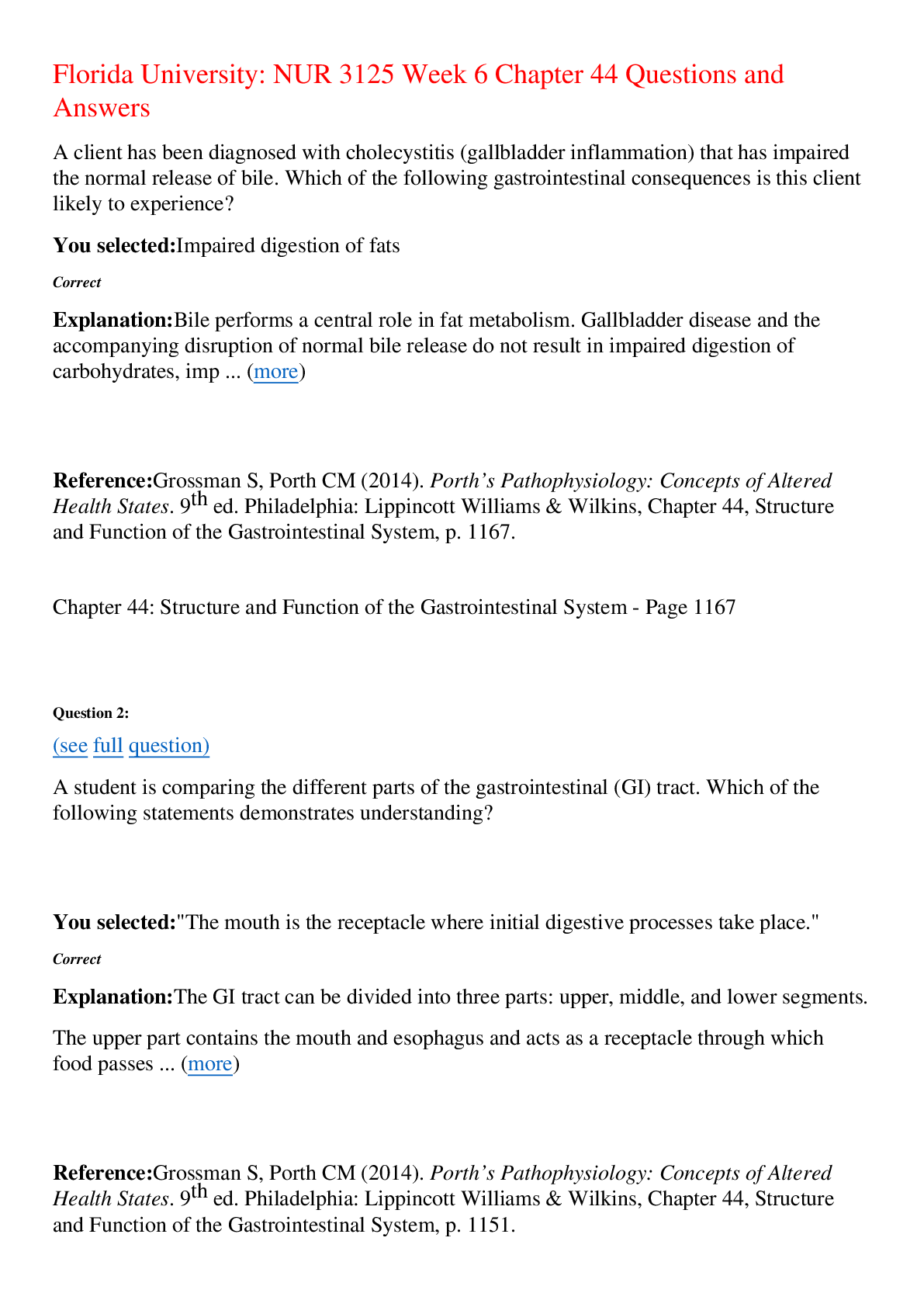
Buy this document to get the full access instantly
Instant Download Access after purchase
Buy NowInstant download
We Accept:

Reviews( 0 )
$14.00
Can't find what you want? Try our AI powered Search
Document information
Connected school, study & course
About the document
Uploaded On
Mar 22, 2023
Number of pages
21
Written in
Additional information
This document has been written for:
Uploaded
Mar 22, 2023
Downloads
0
Views
70


